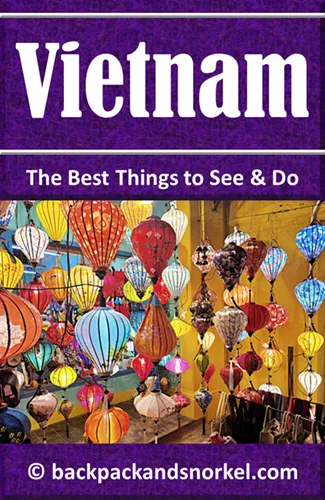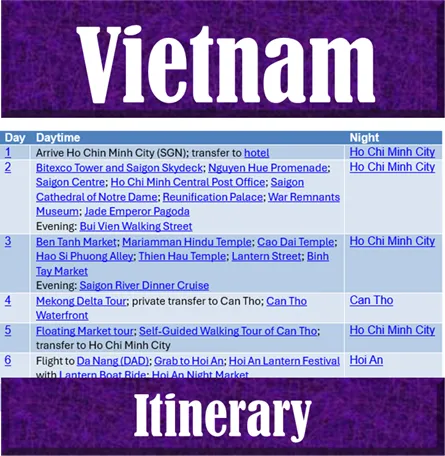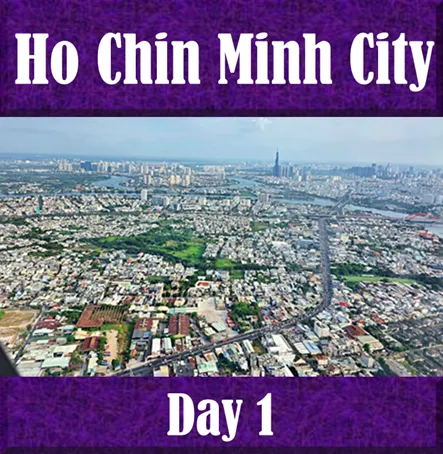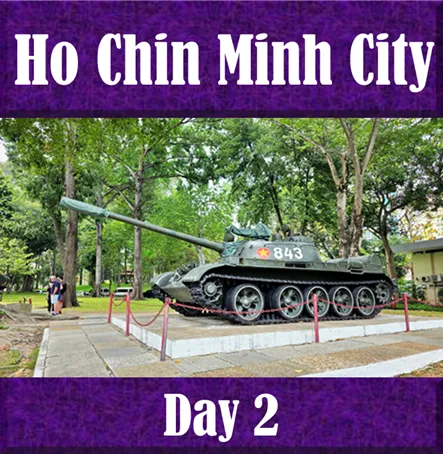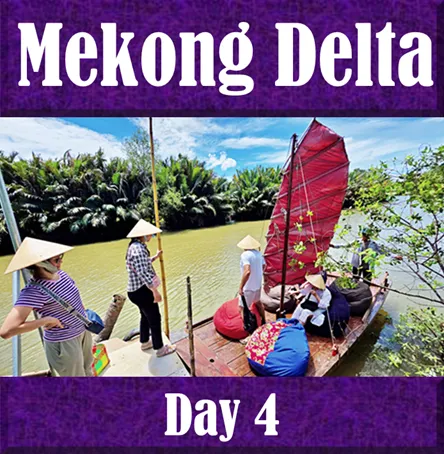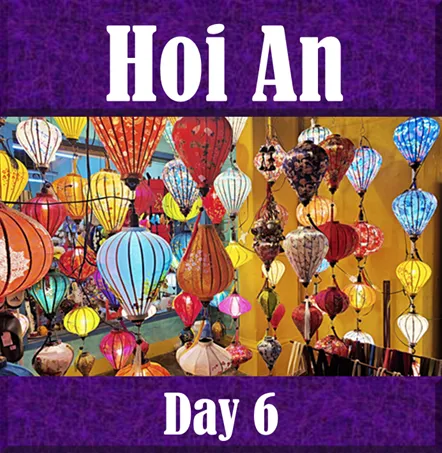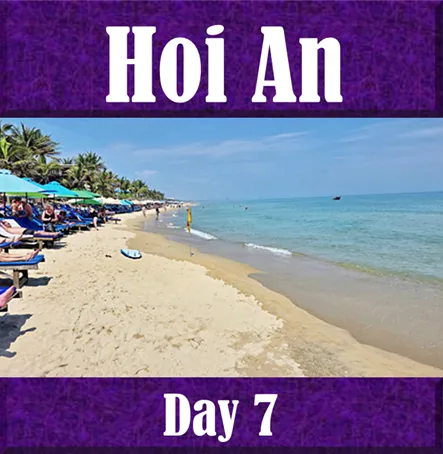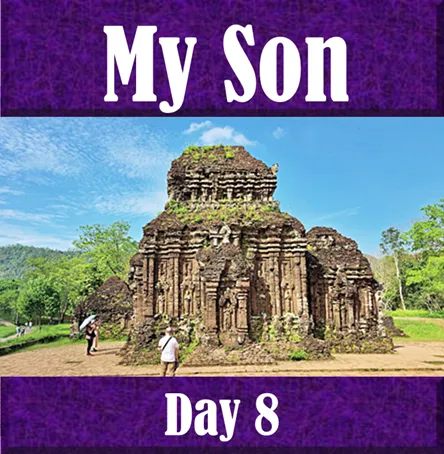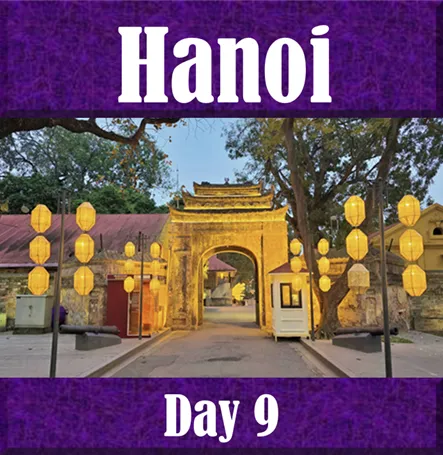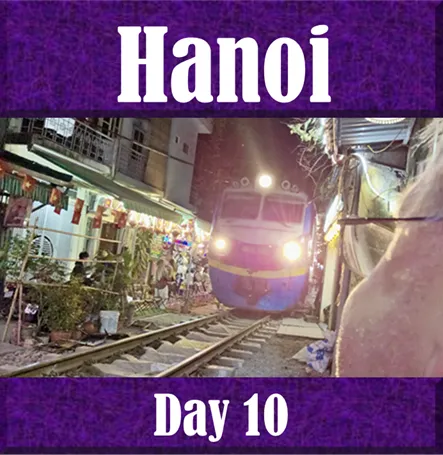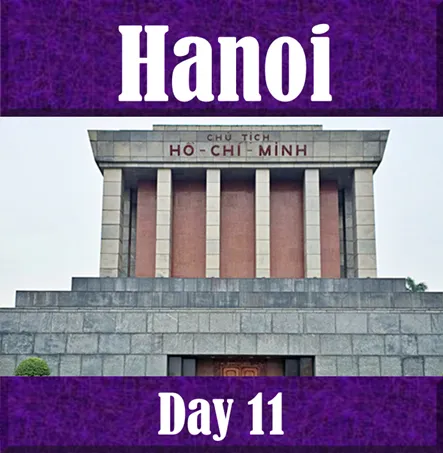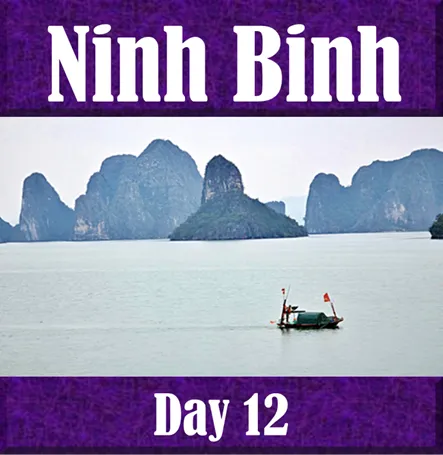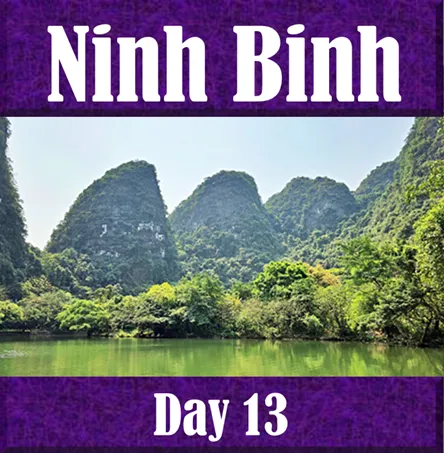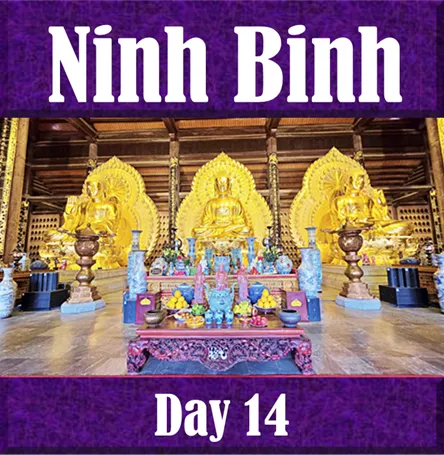Self-Guided Walking Tour of Hoi An’s Ancient Town | Vietnam Purple Travel Guide
At the heart of Hoi An is its historic core, a pedestrian-friendly maze of yellow-washed buildings, wooden shophouses, moss-covered roofs, and vine-draped balconies: Hoi An Ancient Town.
It reflects a unique mix of Vietnamese, Chinese, Japanese, and French influences, a nod to its past as a bustling international port.
Iconic landmarks include the 400-year-old Japanese Covered Bridge, the ornate Fujian Assembly Hall, and Tan Ky Old House, which has been home to generations of Vietnamese merchants.
While there is no admission to enter Hoi An Ancient Town, visitors must purchase a Hoi An Ancient Town ticket to enter the preserved buildings, as well as watch traditional performances at the Hoi An Traditional Art Performance House, and local museums.
The town’s layout, narrow alleys, and traditional guild halls offer a rare glimpse into pre-modern urban life in Asia, making it one of the most atmospheric historical towns in the region.
Where to find Hoi An Ancient Town Ticket Offices
There are 10 ticket offices, mostly at different entrance points of the Ancient Town.
The locations are shown on the map below – this is the map we received where we bought our tickets:
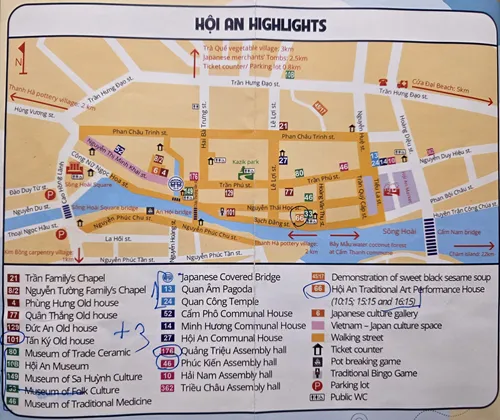
If you stay on An Hoi Island, then the ticket booth (map) at the footbridge to the Ancient Town is likely the best option for you. All ticket offices are unassuming small, yellow-painted wooden huts that you may easily overlook.
Admission to the Ancient Town is 120,000 VND (US$5) per adult at the time of writing.
This is Premium Content! To access it, please download our
Backpack and Snorkel Purple Travel GuideThere are 24 attractions, and your ticket gets you into 5. Since that would be too easy, we were told that there is another rule that we had never heard of before: You can only visit 1 attraction per color (on the map). If you want to visit more, then you have to buy another ticket. This rule, which appears to not be written down anywhere, was indeed enforced when we were there.
It is likely best if you plan your route and then ask the ticket agent to confirm that you can visit the attractions you have chosen. You can find a description of all 24 attractions here.
Self-Guided Tour of Hoi An Ancient Town
This Self-Guided Tour of Hoi An Ancient Town contains some attractions for which you need the Ancient Town Entrance Ticket. You can go everywhere without the ticket, but you will not be able to enter those attractions. As mentioned earlier, we encourage you to review all 24 attractions in Ancient Hoi An, and decide for yourself which you like to visit.
Our Self-Guided Tour of Hoi An Ancient Town has these stops:
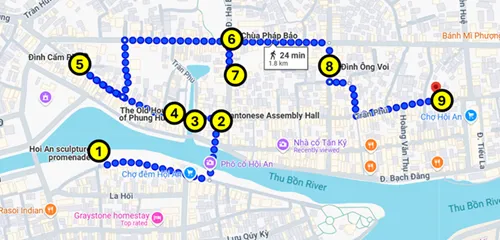

1 = Hoi An Sculpture Promenade
2 = Cantonese Assembly Hall
3 = Japanese Covered Bridge
4 = The Old House of Phung Hung
5 = Cam Pho Communal House
6 = Pháp Bảo Temple
7 = Ba Mu Temple
8 = Đình Ông Voi Village Hall
9 = Fukian Assembly Hall / Hội Quán Phước Kiến
10 = Central Market Food Hall
11 = Museum of Folk Culture
12 = Hoi An Traditional Art Performance House
13 = Old House of Tan Ky
Hoi An Sculpture Promenade
(map, reviews)
This is Premium Content! To access it, please download our
Backpack and Snorkel Purple Travel GuideLocated on the southern banks of the Hoài River, before crossing the iconic An Hoi Bridge to Hoi An Ancient Town lies the spacious An Hoi Sculpture Promenade, a hidden artistic gem that offers a complete change of pace and one of the best perspectives of the Ancient Town. Unlike the ancient houses on the main side, this promenade is a modern, open-air gallery, where you can stroll among a fascinating collection of traditional and contemporary Vietnamese sculptures. The art garden is beautifully set against the river, providing a tranquil, green retreat perfect for quiet contemplation and stunning photography—especially during the golden hours of sunset. Don't miss this serene blend of art and nature! For detailed information, see our Hoi An Sculpture Promenade Guide.
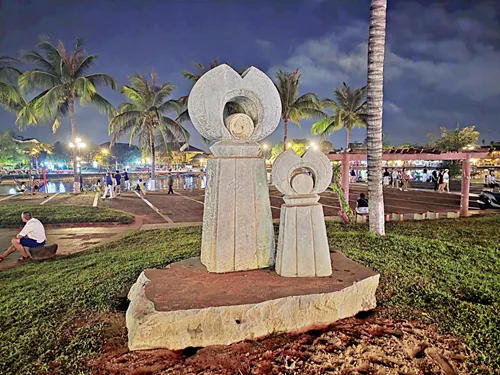
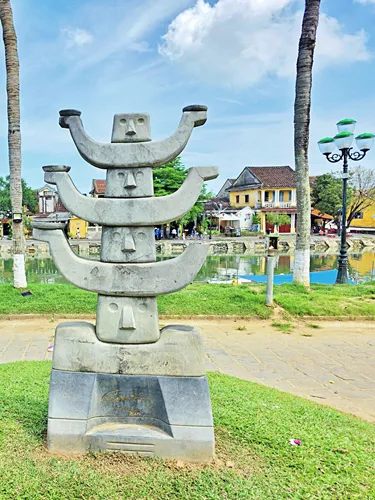
Cantonese Assembly Hall
(map, reviews)
This is Premium Content! To access it, please download our
Backpack and Snorkel Purple Travel GuideTo enter, you need to have purchased the Hoi An Ancient Town Ticket.
Take a moment to step through the ornate, three-door gate of the Cantonese Assembly Hall, and you will instantly be transported back to Hoi An’s golden age as an important trading port. Built by Cantonese merchants in the late 19th century, this hall is a striking architectural blend of stone and richly carved wood, dedicated primarily to the revered Chinese General Quan Cong (Guan Yu)—a symbol of loyalty and justice. Be sure to look for the dazzling, ceramic-tiled Dragon-and-Carp fountain in the courtyard, a stunning masterpiece that beautifully illustrates the legend of perseverance and transformation. This assembly hall is a museum and a living shrine filled with antiques and historical murals that tell the story of the powerful merchant community that shaped this town. For a deeper dive into its dramatic history, and how to spot its unique architectural features, read our Cantonese Assembly Hall Guide.
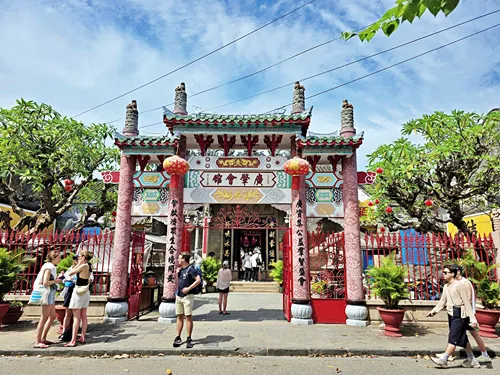
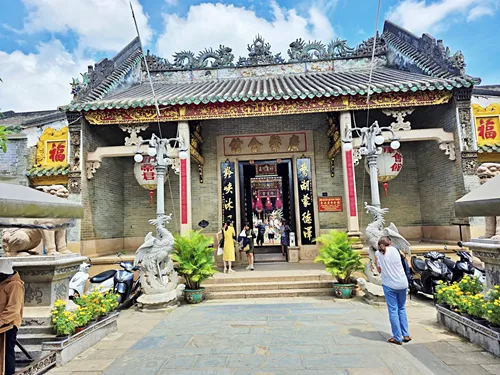
Japanese Covered Bridge
(map, reviews)
This is Premium Content! To access it, please download our
Backpack and Snorkel Purple Travel GuideWalking through the Japanese Covered Bridge is free, but accessing the interior counts as one of your five permitted destinations on the Hoi An Ancient Town Ticket..
The Japanese Covered Bridge is arguably the most recognized symbol of Hoi An and is so significant it is featured on Vietnam’s 20,000 VND banknote. Built by the Japanese community in the 17th century to connect their quarter with the Chinese district, this is not just a bridge, but a working temple on a bridge, known locally as Chùa Cầu (Bridge Pagoda). As you approach, note the guardian statues of a Monkey at one end and a Dog at the other, said to represent the zodiac years the bridge's construction began and ended. Inside the dark, covered passage, you'll find a small shrine dedicated not to Buddha, but to the Northern Deity, Tran Vo Bac De, who controls the weather and prevents floods—a powerful spiritual force for a trading port on a river. Take your time to trace the carvings and admire the seamless blend of Japanese, Vietnamese, and Chinese architectural styles in the curved roof and wooden columns. Click through to our Detailed Guide to the Japanese Covered Bridge here.
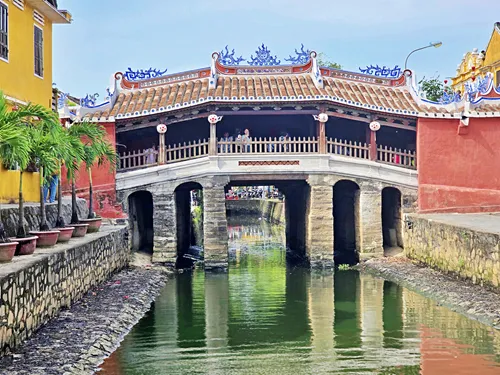
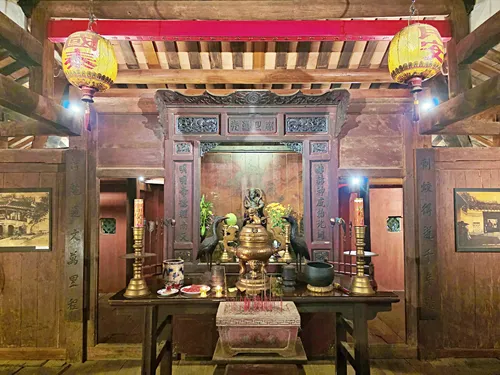
The Old House of Phung Hung
(map, reviews)
This is Premium Content! To access it, please download our
Backpack and Snorkel Purple Travel GuideTo enter, you need to have purchased the Hoi An Ancient Town Ticket.
Our recommendation is to only look at this house from the outside and visit the Old House of Tan Ky instead.
This is one of Hoi An's most famous merchant homes - a 240-year-old architectural marvel where three cultures collide. The Old House of Phung Hung is a stunning fusion of Vietnamese traditional framework, intricate Chinese balconies, and a distinctive Japanese 'Four Seas' roof. This home of a wealthy merchant, still occupied by the 8th generation of the family, is far more than just beautiful woodwork and antiques; it’s a masterclass in survival. Look for the fascinating, indigenous design detail—a square trapdoor on the upper floor—which tells a vital story of how the family saved their priceless goods from the devastating annual floods. Discover the protective "door eyes" to the family's ancient trading methods and read our guide to The Old House of Phung Hung.
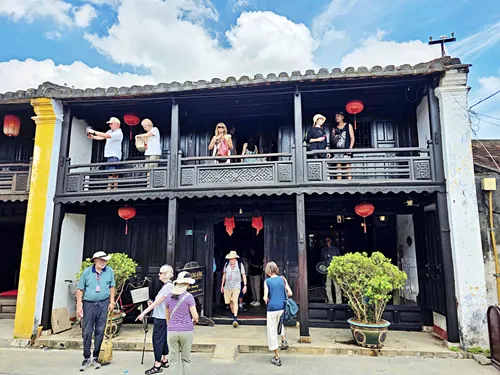
Cam Pho Communal House
(map, reviews)
This is Premium Content! To access it, please download our
Backpack and Snorkel Purple Travel GuideTo enter, you need to have purchased the Hoi An Ancient Town Ticket.
Take a look at the Cẩm Phô Communal House, a testament to pure Vietnamese communal architecture dating back to the late 15th century. Built long before the town's international trading peak, this serene complex contrasts beautifully with the merchant homes, boasting a majestic layout in the shape of the Chinese character for 'country'. As you approach the intricately carved three-door gate, pause to feel the centuries of history in the air, then step inside to admire the magnificent woodwork and the central altar dedicated to the local guardian deities and the Goddess of the River—a powerful reminder of the Thu Bồn's vital role in the town's destiny. Click Here for Our Detailed Guide to Cẩm Phô Communal House: guide.
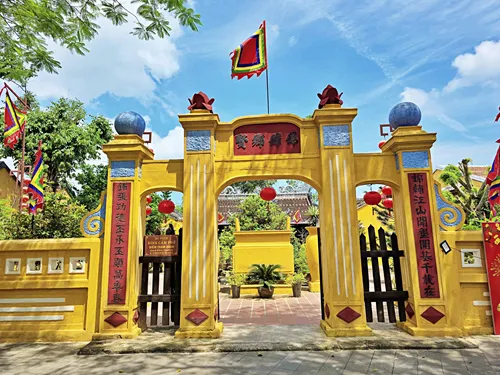
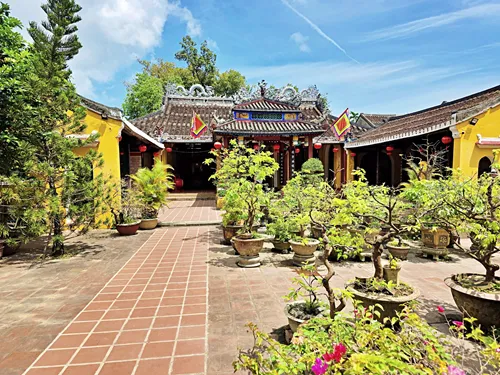
Pháp Bảo Temple
(map, reviews)
This is Premium Content! To access it, please download our
Backpack and Snorkel Purple Travel GuidePháp Bảo Temple is not part of the Hoi An Ancient Town Ticket. You can freely visit it.
Pháp Bảo Temple is Hoi An's largest and most significant Buddhist pagoda, which serves as the heart of the local Buddhist Association. Despite its central location in the Ancient Town, this free-to-enter temple offers a peaceful retreat where the ancient Vietnamese architectural style is expressed through an elaborate two-story structure, a striking triple-arch gate, and roofs adorned with vivid dragons and phoenixes. As you remove your shoes to enter the main hall, you will find yourself surrounded by the powerful serenity of the Three Buddhas, flanked by Bodhisattvas, with a central courtyard lush with vibrant gardens and the striking sight of its golden-red decor. Click Here for Our Detailed Guide to Pháp Bảo Temple.
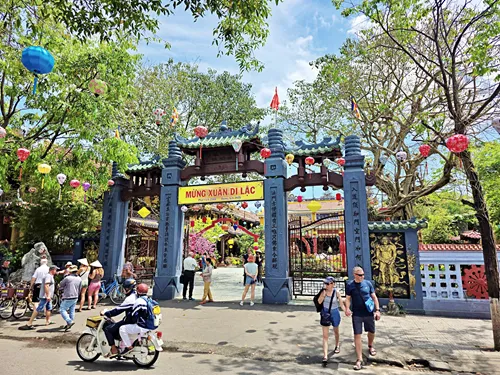
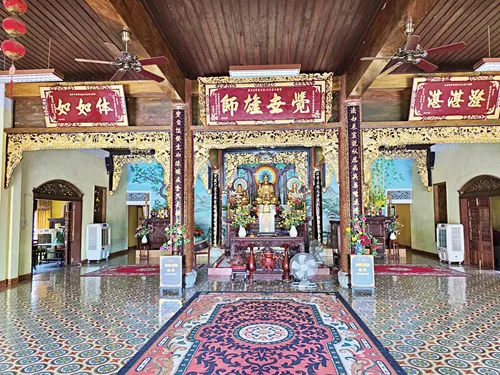
Ba Mu Temple Gate
(map, reviews)
This is Premium Content! To access it, please download our
Backpack and Snorkel Purple Travel GuideBa Mu Temple Gate is not part of the Hoi An Ancient Town Ticket. You can freely visit it.
The Ba Mu Temple Gate, the exquisitely preserved 17th-century entrance to what was once one of Hoi An's most important religious complexes, is now one of the town's most sought-after photographic attraction. Distinct from the typically austere temple entrances in Vietnam, this UNESCO-listed tam quan (three-arch gate) immediately draws the eye with its restored blue and red colors, and intricately carved East Asian motifs. Don't miss the calm, rectangular water lily pond directly in front of the gate. While the original temple structures behind the gate are gone (now a local school), the gate itself stands as a majestic, free-to-visit symbol of Hoi An's rich spiritual and architectural heritage, dedicated to the Gods of Fertility and the Twelve Midwives. Click Here for Our Detailed Guide to Ba Mu Temple Gate.
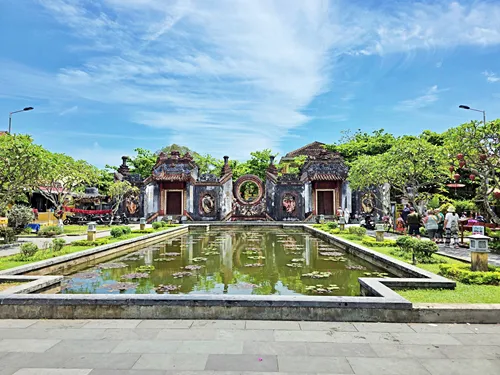
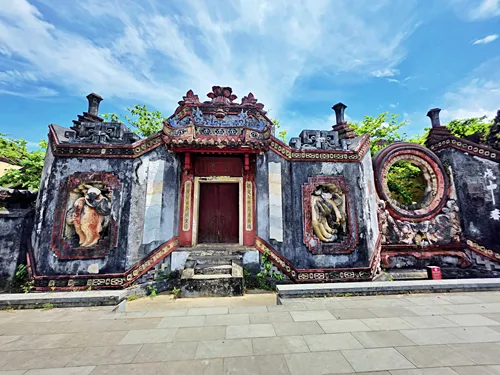
Đình Ông Voi Village Hall
(map, reviews)
This is Premium Content! To access it, please download our
Backpack and Snorkel Purple Travel GuideĐình Ông Voi Village Hall is not part of the Hoi An Ancient Town Ticket. You can freely visit it.
The Đình Ông Voi Village Hall is known locally as the 'Elephant Communal House' due to the two surviving stone elephant statues that flank its entrance. This large-scale, 300-year-old communal house, a centerpiece of the historic Hội An village, showcases the sophisticated architecture of the region, featuring elaborate wooden carvings by master craftsmen from the nearby Kim Bồng Carpentry Village, and its main hall resting on unique monolithic stone columns carved with Sino-Vietnamese couplets. Click Here for Our Detailed Guide to Đình Ông Voi
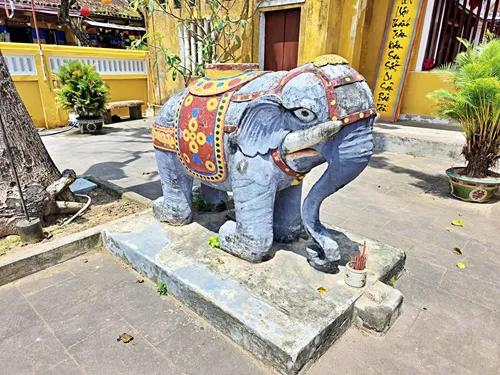
Fukian Assembly Hall / Hội Quán Phước Kiến
(map, reviews)
This is Premium Content! To access it, please download our
Backpack and Snorkel Purple Travel GuideTo enter, you need to have purchased the Hoi An Ancient Town Ticket.
The Fukian Assembly Hall (Phúc Kiến), is Hoi An's most magnificent and vibrant assembly hall, built by Chinese merchants from the Fujian province in the late 17th century as a gathering space that later became a sacred temple for Thien Hau, the Goddess of the Sea. The journey of discovery begins at the bright pink, triple-arched Tam Quan gate, a stunning photo backdrop adorned with glazed tile sculptures of mythical beasts like dragons and unicorns, symbolizing power and knowledge. As you walk through the spacious inner courtyards, look for the central mosaic fountain featuring the revered Dragon Carp—a symbol of achievement. The heart of the hall is the stunning main sanctuary, where you can see massive, sweetly fragrant circular incense coils hanging from the ceiling; observe visitors writing their wishes on paper and attaching them to these coils, a unique local ritual you can participate in. Don't miss the detailed miniature wooden boat on the left side of the main hall, a model of an ancient merchant ship dedicated to safe sea travels, which vividly connects the hall's spiritual function to Hoi An's history as a bustling international port. Click Here for Our Detailed Guide to the Fukian Assembly Hall.
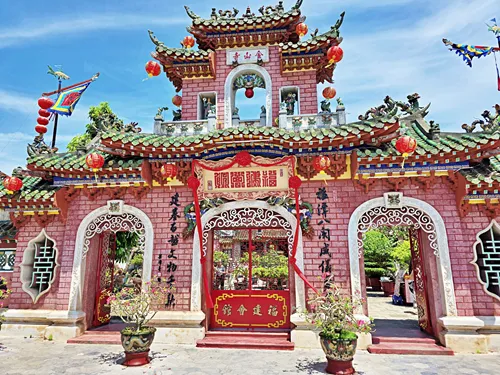
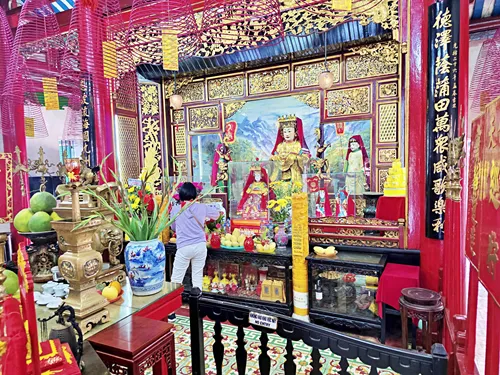
Central Market with Food Hall
(map, reviews)
This is Premium Content! To access it, please download our
Backpack and Snorkel Purple Travel GuideHoi An's Central Market is not part of the Hoi An Ancient Town Ticket. You can freely visit it.
Hoi An’s Central Market is the beating, bustling heart of the town, offering a sensory explosion and an unparalleled glimpse into local life that starts before sunrise. The true highlight for any self-guided adventurer, however, is the indoor Food Hall, where you can take a seat at the long communal tables, observe the clear pricing on the walls, and point to sample authentic, inexpensive Hoi An specialty dishes like Cao Lầu noodles and Bánh Xèo (savory pancakes) prepared right in front of you. Don't forget to wander through the adjacent Cloth Market for a mesmerizing display of colorful silks and a peek at the fast-paced tailoring trade before emerging back into the ancient streets laden with souvenirs and the taste of authentic Central Vietnamese cuisine. Click Here for Our Detailed Guide to the Central Market.
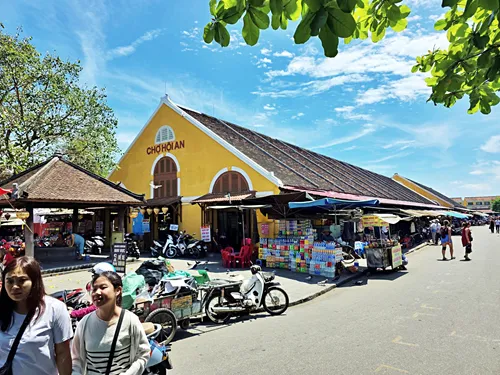

Museum of Folk Culture
(map, reviews)
This is Premium Content! To access it, please download our
Backpack and Snorkel Purple Travel GuideTo enter, you need to have purchased the Hoi An Ancient Town Ticket. Be advised that, if you follow our Self-Guided Tour of Hoi An Ancient Town, you may only have 2 more attractions left. Our advice is to rather use them for Hoi An Traditional Art Performance House, and Old House of Tan Ky.
Hoi An Museum of Folk Culture is housed in one of the city's largest and most beautifully preserved ancient 'tube houses'. This museum offers an intimate look at the tangible and intangible heritage of the region. Through captivating exhibits on traditional costumes, folk crafts, and performance arts, you'll gain a deeper appreciation for the generations of residents who shaped this UNESCO World Heritage Site. Click here for the detailed guide for visiting the Museum of Folk Culture.
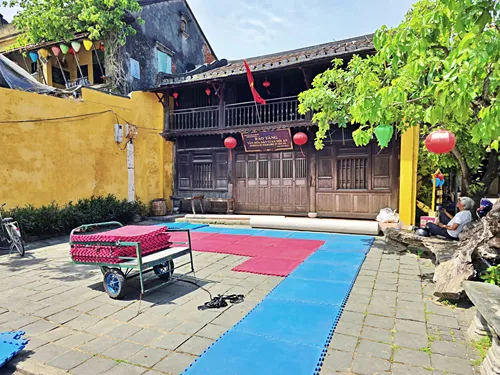
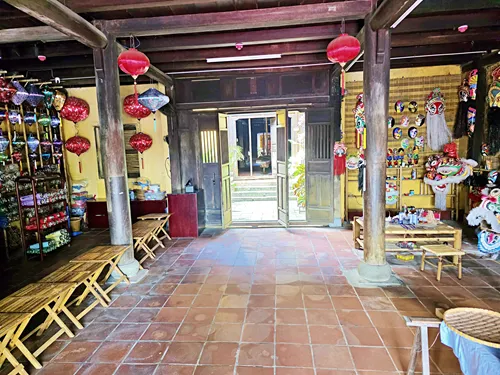
Hoi An Traditional Art Performance House
(map, reviews)
This is Premium Content! To access it, please download our
Backpack and Snorkel Purple Travel GuideTo see a show, you need to have purchased the Hoi An Ancient Town Ticket. Be advised that the shows are popular for very good reason, and arrive at least 30 min before show time at 10:15am, 3:15pm, 4:15pm.
If you cannot make it, but plan to go to My Son tomorrow, then you will have a chance to see a similar but shorter show at the My Son historic site that covers some of what you see during this show.
Give your feet a rest and treat your senses to an authentic cultural moment at the Hoi An Traditional Art Performance House. Right in the heart of the Ancient Town, this is where the vibrant, centuries-old traditions of Central Vietnam truly come to life. In a beautifully preserved setting, you can witness short, enthralling performances of folk singing, traditional dance, and unique theatrical acts like the renowned Bài Chòi (a local, musical bingo game). This stop provides a perfect, colorful insight into the living arts that have defined Hoi An's intangible heritage for generations, adding a dynamic, human element to your architectural tour. Click here for performance schedules, and essential visitor information for the Traditional Art Performance House
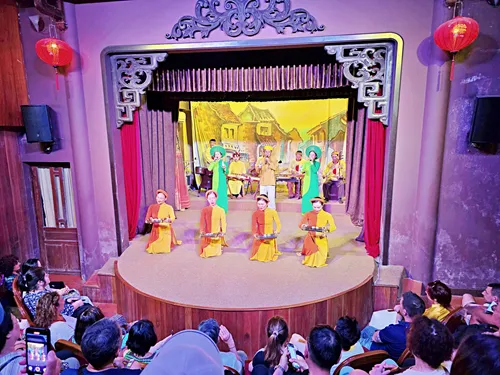
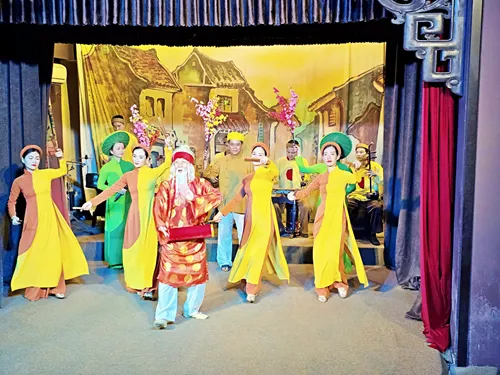
Old House of Tan Ky
(map, reviews)
This is Premium Content! To access it, please download our
Backpack and Snorkel Purple Travel GuideTo enter, you need to have purchased the Hoi An Ancient Town Ticket..
No visit to the Ancient Town is complete without stepping inside the legendary Old House of Tan Ky. This remarkable 200-year-old merchant home offers a rare and intimate glimpse into the life of a prosperous seven-generation family, remaining incredibly well-preserved and still occupied by their descendants today. Marvel at the stunning architectural blend of Vietnamese, Chinese, and Japanese influences—notice the unique cross-beams and a roof supported by pillars that look like they belong on a Japanese temple—all while standing in rooms filled with precious antiques and unique mother-of-pearl calligraphy. It is a genuine living museum of Hoi An's vibrant trading past. Click here for a detailed look inside the Tan Ky Old House.
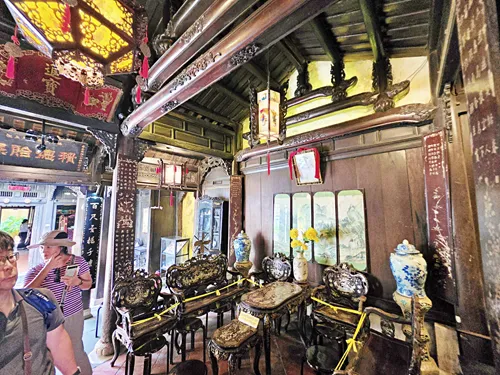
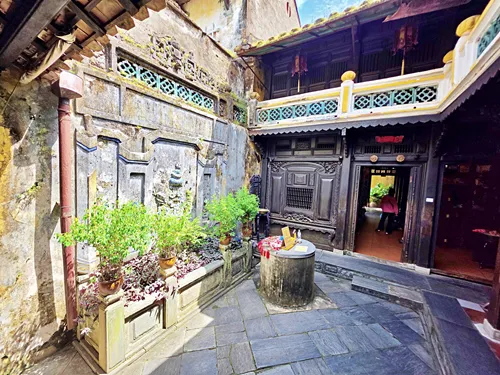
All 24 Attractions of the Hoi An Ancient Town Ticket
The Hoi An Ancient Town Ticket includes admission to 24 attractions as shown on the map below. Please read through all descriptions to decide which 5 (or more) attractions you like to see. And don’t forget: Our Self-Guided Hoi An Ancient Town Tour adds several beautiful free sites that are not part of the ticket.

#21 - Tran Family’s Chapel
#8/2 – Nguyen Toung Family’s Chapel
#4 – Phung Hung Old House
#77 – Quan Thang Old House
#129 – Duc An Old House
#101 - Old House of Tan Ky
#80 – Museum of Trade Ceramic
#10B – Hoi An Museum
#149 – Museum of Sa Huynh Culture
#33 – Museum of Folk Culture
#46 – Museum of Traditional Medicine
Japanese Covered Bridge
#13 – Quan Am Pagoda
#24 – Quan Cong Temple
#52 – Cam Pho Communal House
#14 – Minh Huong Communal House
#27 – Hoi An Communal House
#176 – Quang Trieu Assembly Hall
#46 – Phuc Kien Assembly Hall
#10 – Hai Nam Assembly Hall
#362 – Trieu Chau Assembly Hall
#45/17 - Demonstration of sweet black sesame soup
#66 – Hoi An traditional Art Performance House
#6 – Japanese Culture Space
#21 - Tran Family’s Chapel
(map, reviews)
This is Premium Content! To access it, please download our
Backpack and Snorkel Purple Travel GuideEnter the peaceful compound of the Tran Family's Chapel, one of the most culturally significant sites in Hoi An. Built in 1802 by a mandarin to worship his ancestors, this chapel is a testament to Vietnam's deeply rooted tradition of ancestor veneration. As you explore its serene courtyard and intricate wooden architecture, which is a beautiful blend of Chinese, Japanese, and Vietnamese styles, you will gain insight into the hierarchy, history, and spiritual devotion of one of the town’s most influential clans. Click here to read our detailed guide of Tran Family’s Chapel.
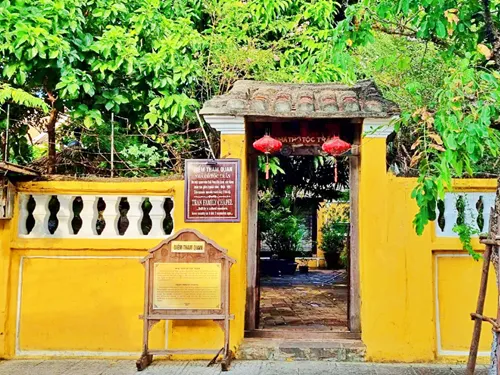
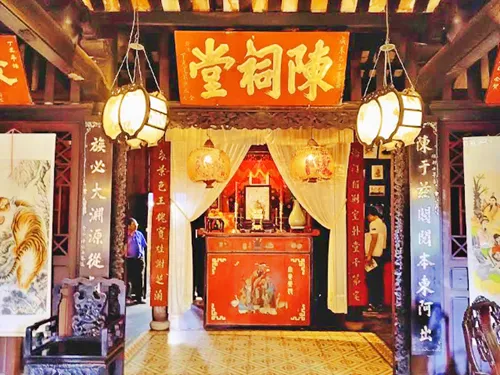
#8/2 – Nguyen Tuong Family’s Chapel
(map, reviews)
This is Premium Content! To access it, please download our
Backpack and Snorkel Purple Travel GuideTucked away in a quiet alley, the Nguyen Tuong Family’s Chapel connects Hoi An's past to modern Vietnamese culture. Built in 1806 for a high-ranking mandarin, this tranquil ancestral house features the rare, elegant architecture of Hue, and also preserves priceless royal decrees and documents. Most fascinatingly, this is the ancestral home of the famed literary trio—Nhat Linh, Thach Lam, and Hoang Dao—who founded a key modern literary group. A visit here is a chance to walk the grounds where a prestigious family of scholars and writers made their mark, both on the imperial court and on Vietnamese literature. Read our detailed Nguyen Tuong Family’s Chapel Guide for more information.
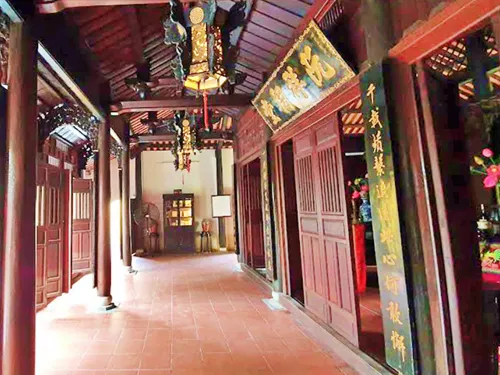
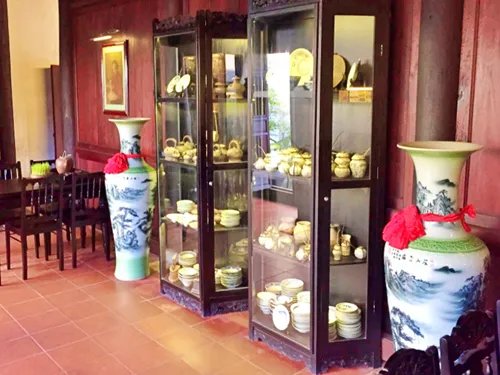
#4 – Phung Hung Old House
(map, reviews)
This is Premium Content! To access it, please download our
Backpack and Snorkel Purple Travel GuideOur recommendation is to only look at this house from the outside and visit the Old House of Tan Ky instead.
This is one of Hoi An's most famous merchant homes - a 240-year-old architectural marvel where three cultures collide. The Old House of Phung Hung is a stunning fusion of Vietnamese traditional framework, intricate Chinese balconies, and a distinctive Japanese 'Four Seas' roof. This home of a wealthy merchant, still occupied by the 8th generation of the family, is far more than just beautiful woodwork and antiques; it’s a masterclass in survival. Look for the fascinating, indigenous design detail—a square trapdoor on the upper floor—which tells a vital story of how the family saved their priceless goods from the devastating annual floods. Discover the protective "door eyes" to the family's ancient trading methods and read our guide to The Old House of Phung Hung.

#77 – Quan Thang Old House
(map, reviews)
This is Premium Content! To access it, please download our
Backpack and Snorkel Purple Travel GuideStop at the over 150-year-old Quan Thang Old House to experience one of Hoi An's best-preserved merchant residences, built by a wealthy Chinese captain. Its spectacular architecture showcases the finest artistry from the famous Kim Bong carpentry village. Notice the highly unique Huaxia Chinese-style carvings of flowers and peacocks adorning the beams, and observe how the central courtyard brings natural light and cool air into the long, tube-shaped dwelling. Stepping inside is a step back to the city's golden age of trade, giving you a tangible sense of the refined life led by the merchant class that shaped the Ancient Town. Find more information in our detailed Quan Thang Old House guide.
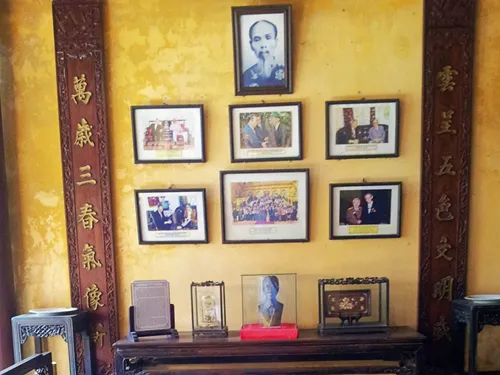
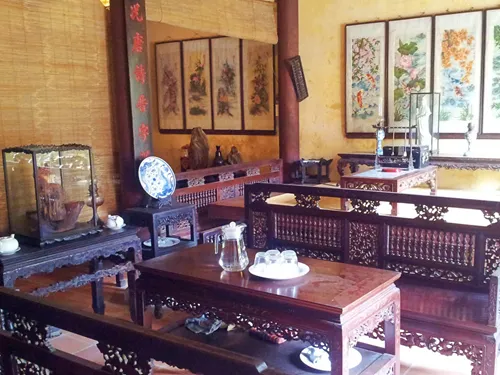
#129 – Duc An Old House
(map, reviews)
This is Premium Content! To access it, please download our
Backpack and Snorkel Purple Travel GuideThe Duc An Old House is unlike the others; built in 1830, this beautiful tube house initially functioned as a famous bookstore, specializing in Han-Nom literature and quietly evolving into a crucial secret meeting place for Vietnamese patriots during the anti-French resistance. While admiring its preserved Central Vietnamese 'ruong' house architecture—notably its unique 'roof over roof' structure and rare, horizontally paneled wooden doors—you are standing in a living monument to intellectual and revolutionary history. Look for the original bookcases and medicine cabinets, which preserve the memory of the family's dual role as merchants and quiet revolutionaries, including the notable figure Cao Hong Lanh. Find more information in our detailed Duc An Old House guide.
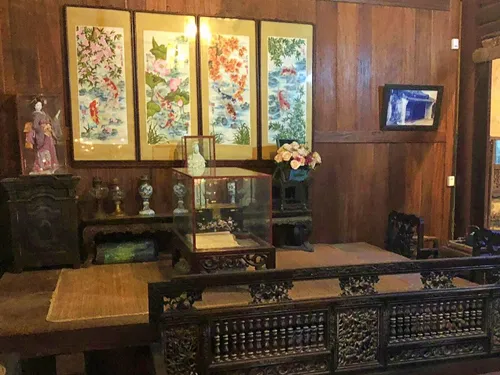
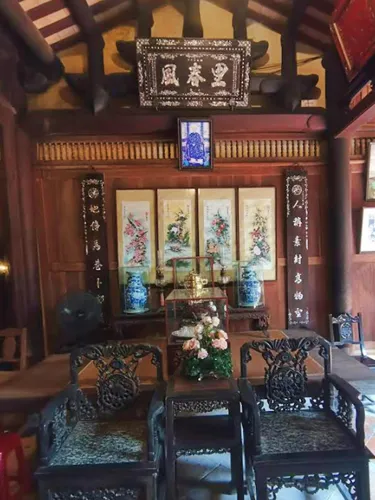
#101 - Old House of Tan Ky
(map, reviews)
This is Premium Content! To access it, please download our
Backpack and Snorkel Purple Travel GuideNo visit to the Ancient Town is complete without stepping inside the legendary Old House of Tan Ky. This remarkable 200-year-old merchant home offers a rare and intimate glimpse into the life of a prosperous seven-generation family, remaining incredibly well-preserved and still occupied by their descendants today. Marvel at the stunning architectural blend of Vietnamese, Chinese, and Japanese influences—notice the unique cross-beams and a roof supported by pillars that look like they belong on a Japanese temple—all while standing in rooms filled with precious antiques and unique mother-of-pearl calligraphy. It is a genuine living museum of Hoi An's vibrant trading past. Click here for a detailed look inside the Tan Ky Old House.


#80 – Museum of Trade Ceramics
(map, reviews, website)
This is Premium Content! To access it, please download our
Backpack and Snorkel Purple Travel GuideThe Museum of Trade Ceramics is housed in a beautifully preserved, traditional two-story wooden merchant's house, showcasing the typical architecture of the 19th-century trading port, complete with its open-air courtyard and a valuable second-floor balcony offering views of Tran Phu Street. Inside, you will discover over 430 pieces of pottery and porcelain, some dating back to the 9th century, that vividly demonstrate Hoi An's golden era as a major international hub—look closely for rare finds recovered from a 15th-century shipwreck off the Cham Islands, proving the town's deep trade connections with Japan, China, India, and the Middle East, giving you a tangible link to a centuries-old global economy. Find out more about the museum, visit our detailed Museum of Trade Ceramics guide.
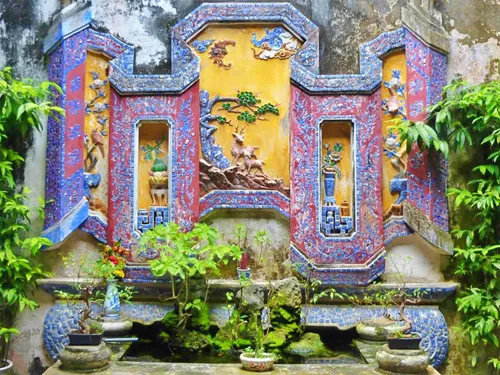
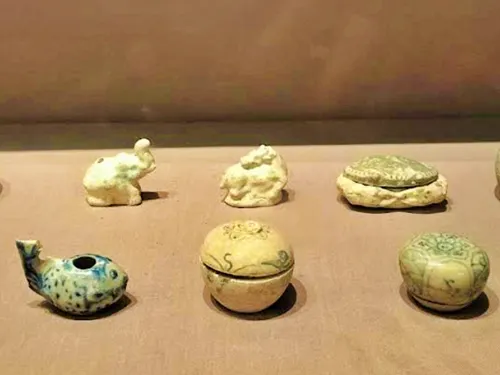
#10B – Hoi An Museum
(map, reviews)
This is Premium Content! To access it, please download our
Backpack and Snorkel Purple Travel GuideThe Hoi An Museum of History and Culture provides the most comprehensive overview of the town's life, from its origins in the ancient Sa Huynh Culture (1000 BC) to its golden age as the bustling Champa and Dai Viet trading port, and through to its modern era, all housed within the exquisitely preserved Quan Am Pagoda (a Buddhist temple built behind the Quan Cong Temple). This unique setting combines history with spirituality, allowing you to trace the town's timeline through over 350 artifacts, including two-thousand-year-old burial jars from the Sa Huynh people, intricate stone and wooden sculptures from the Champa Kingdom, and original documents about the former Faifo trading port. The architecture itself is a blend of Vietnamese and Chinese influences—a physical testament to the international exchange you're learning about—allowing you to immerse yourself in history while admiring the beauty of a centuries-old place of worship. Find more information in our detailed Hoi An Museum guide.
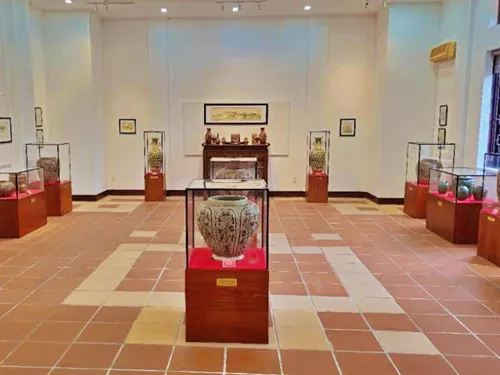
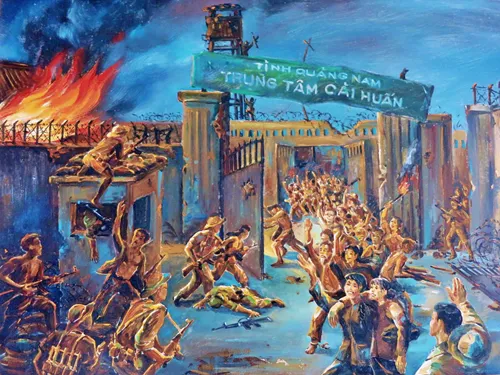
#149 – Museum of Sa Huynh Culture
(map, reviews)
This is Premium Content! To access it, please download our
Backpack and Snorkel Purple Travel GuideThe Museum of Sa Huynh Culture offers a glimpse into the Iron Age civilization that first established a sophisticated trading culture in Central Vietnam from 1000BC to 200AD. Housed in a charming, traditional Hoi An building—painted the distinctive ancient yellow and featuring wooden accents—the museum displays the richest and most unique collection of Sa Huynh artifacts in Vietnam. The centerpiece of the collection is the spectacular array of over 200 well-preserved burial jars (earthenware urns used for funerary rituals), offering profound insight into the spiritual life and complex belief system of the ancient inhabitants. Additionally, you will discover stunning examples of their craftsmanship, including exquisite gold and gemstone jewelry (such as the famed three-pointed earrings) and a range of advanced metal tools and weapons, which provide clear evidence of the Sa Huynh people's flourishing trade links with regions as far as China and India. Please see our detailed Museum of Sa Huynh Culture guide for more information.
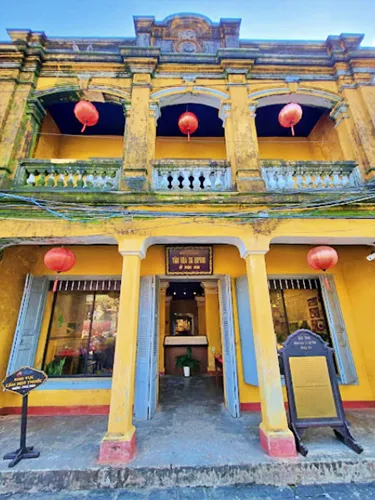
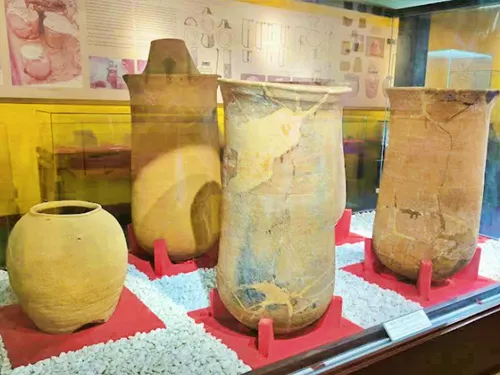
#33 – Museum of Folk Culture
(map, reviews)
This is Premium Content! To access it, please download our
Backpack and Snorkel Purple Travel GuideHoi An Museum of Folk Culture is housed in one of the city's largest and most beautifully preserved ancient 'tube houses'. This museum offers an intimate look at the tangible and intangible heritage of the region. Through captivating exhibits on traditional costumes, folk crafts, and performance arts, you'll gain a deeper appreciation for the generations of residents who shaped this UNESCO World Heritage Site. Click here for the detailed guide for visiting the Museum of Folk Culture.


#46 – Museum of Traditional Medicine
(map, reviews)
This is Premium Content! To access it, please download our
Backpack and Snorkel Purple Travel GuideThe Museum of Traditional Medicine is a fascinating journey into Vietnam's long and rich history of Eastern healing arts, housed within a beautifully preserved traditional two-story Hoi An ancient house, featuring a classic wooden-column structure and tranquil inner courtyard. The museum vividly recreates the atmosphere of a 17th-century herbal medicine shop, complete with detailed exhibits showcasing over 200 artifacts, including huge, antique medicine cabinets with hundreds of small drawers, ancient medical tools (like acupuncture needles and slicers), and rare herbal remedies and documents. Visitors can trace the origins of both Vietnamese traditional medicine (Thuốc Nam) and Chinese herbal medicine (Thuốc Bắc) that flourished during Hoi An's time as the Faifo trading port. The discovery experience is enhanced by a recreated pulse-diagnosis room and an open-air courtyard used for drying and processing herbs, offering a sensory and educational look at a vital aspect of local culture. Read more about the museum in our detailed Museum of Traditional Medicine guide.
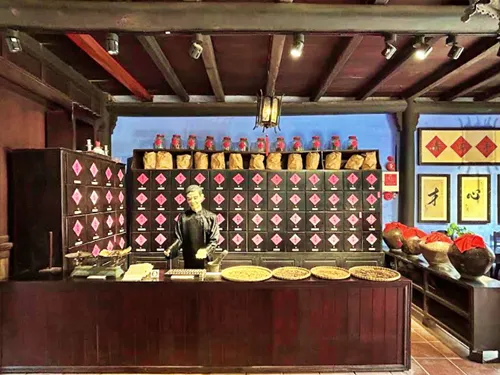
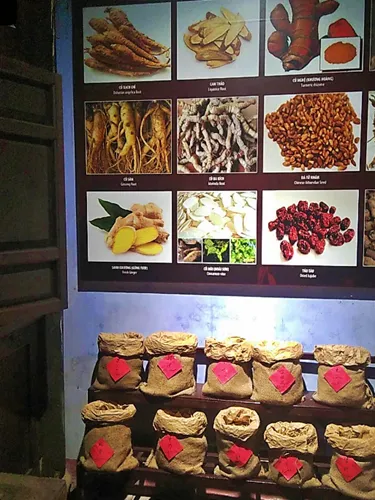
Japanese Covered Bridge
(map, reviews)
This is Premium Content! To access it, please download our
Backpack and Snorkel Purple Travel GuideWalking through the Japanese Covered Bridge is free, but accessing the interior counts as one of your five permitted destinations on the Hoi An Ancient Town Ticket..
The Japanese Covered Bridge is arguably the most recognized symbol of Hoi An and is so significant it is featured on Vietnam’s 20,000 VND banknote. Built by the Japanese community in the 17th century to connect their quarter with the Chinese district, this is not just a bridge, but a working temple on a bridge, known locally as Chùa Cầu (Bridge Pagoda). As you approach, note the guardian statues of a Monkey at one end and a Dog at the other, said to represent the zodiac years the bridge's construction began and ended. Inside the dark, covered passage, you'll find a small shrine dedicated not to Buddha, but to the Northern Deity, Tran Vo Bac De, who controls the weather and prevents floods—a powerful spiritual force for a trading port on a river. Take your time to trace the carvings and admire the seamless blend of Japanese, Vietnamese, and Chinese architectural styles in the curved roof and wooden columns. Click through to our Detailed Guide to the Japanese Covered Bridge here.


#13 – Quan Am Pagoda
(map, reviews)
This is Premium Content! To access it, please download our
Backpack and Snorkel Purple Travel GuideThe Quan Am Pagoda (also known as Minh Huong Temple or Lady Buddha Temple) is one of Hoi An's oldest and most sacred Buddhist sites, dating back to at least 1653, and originally built by the local Minh Huong villagers (descendants of Chinese settlers). Located behind the Quan Cong Temple complex, its architecture is characterized by a tranquil blend of traditional Vietnamese and Chinese styles, notably featuring a massive and intricate wooden truss, column, and rafter system crafted by the famed Kim Bong carpentry artisans. The main hall, though humble in scale, is a dignified space for the worship of the Amitabha Trinity, with the central altar dedicated to the Goddess of Mercy, Avalokitesvara Bodhisattva (Quan Am), a patron deity for seafarers and traders. To discover the pagoda, please read our detailed Quan Am Pagoda guide.
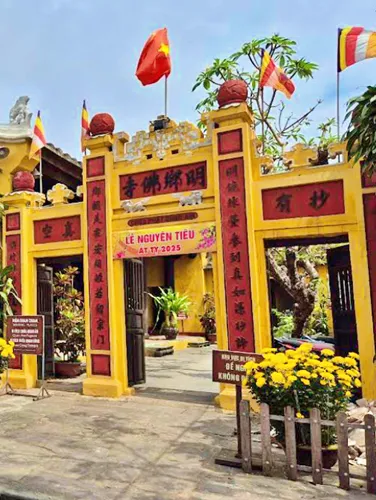
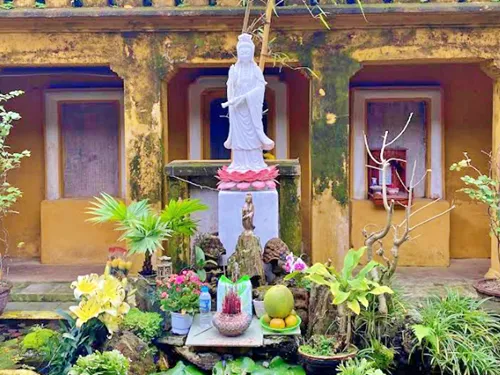
#24 – Quan Cong Temple
(map, reviews)
This is Premium Content! To access it, please download our
Backpack and Snorkel Purple Travel GuideThe Quan Cong Temple (or Ông Pagoda), founded in 1653, is one of Hoi An's most sacred landmarks, built by Chinese merchants to honor the legendary General Quan Cong, a deified symbol of loyalty, honesty, and justice. The temple’s architecture is a classical Chinese Confucian design featuring a layout that follows the Chinese character '国' (Quốc, meaning country) and is dazzlingly adorned with red, yellow, and green glazed tiles, intricate wood carvings, and a stunning 3-meter-tall, red-faced statue of the General in the main sanctuary. Key exhibits include the life-size statues of his two loyal war horses, the White Horse and the famed Red Hare. To truly discover a place for yourself, participate in the local custom of seeking good fortune by crawling through the belly of the Red Hare horse statue (a symbolic act of cleansing and seeking protection) or take part in the unique "borrowing and returning blessings" ritual, a profound demonstration of local faith and gratitude. Read more abou the temple in our detailed Quan Cong Temple guide.
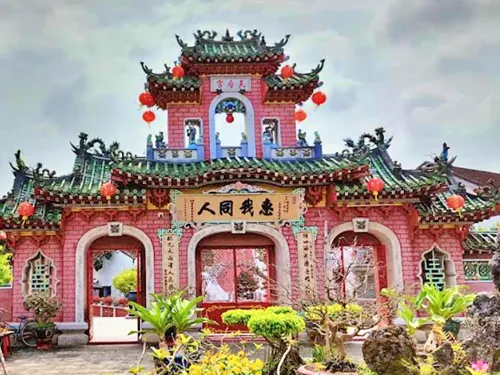
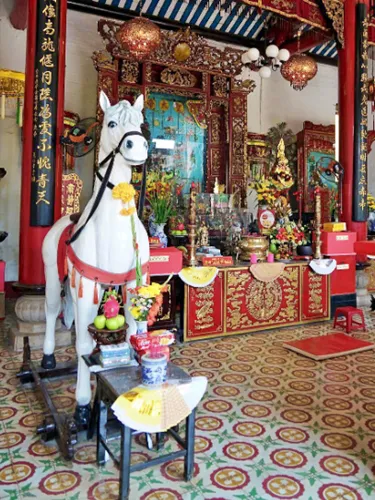
#52 – Cam Pho Communal House
(map, reviews)
This is Premium Content! To access it, please download our
Backpack and Snorkel Purple Travel GuideTake a look at the Cẩm Phô Communal House, a testament to pure Vietnamese communal architecture dating back to the late 15th century. Built long before the town's international trading peak, this serene complex contrasts beautifully with the merchant homes, boasting a majestic layout in the shape of the Chinese character for 'country'. As you approach the intricately carved three-door gate, pause to feel the centuries of history in the air, then step inside to admire the magnificent woodwork and the central altar dedicated to the local guardian deities and the Goddess of the River—a powerful reminder of the Thu Bồn's vital role in the town's destiny. Click Here for Our Detailed Guide to Cẩm Phô Communal House: guide.


#14 – Minh Huong Communal House
(map, reviews)
This is Premium Content! To access it, please download our
Backpack and Snorkel Purple Travel GuideThe Minh Huong Communal House (also known as Tuy Tien Duong Minh Huong) is the most vital spiritual building for the Minh Huong people—Chinese descendants who adopted Vietnamese citizenship—and serves as a sacred place to worship the community's founding ancestors (Tiên Hiền). Built in the style of the Chinese character '国' (Guó, meaning country) and crafted by the famous artisans of the Kim Bong Carpentry Village, the architecture is a stunning showcase of exquisite wooden doors, intricate gilded incense tables, and masterful carvings that blend Chinese and Vietnamese styles. Unlike temples dedicated to specific gods, the main hall features red tablets inscribed with names rather than statues, deeply reflecting the ancestral and Confucian focus of the community. Learn more in our detailed Minh Huong Communal House guide.
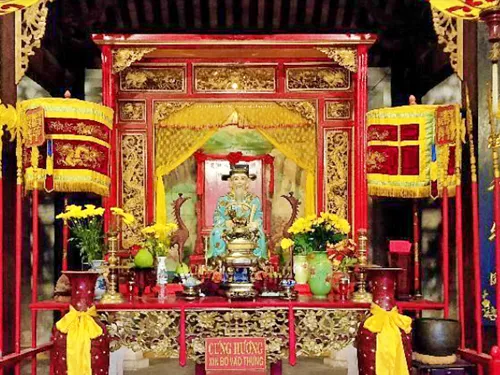
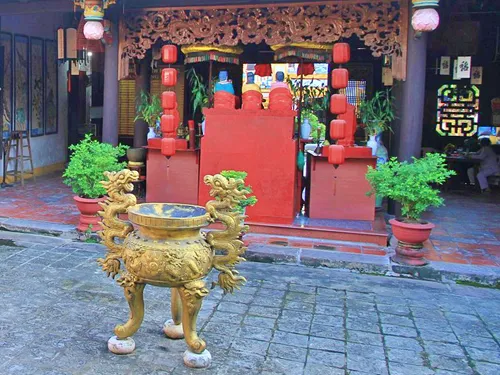
#27 – Hoi An Communal House (Ông Voi Communal House)
(map, reviews)
This is Premium Content! To access it, please download our
Backpack and Snorkel Purple Travel GuideThe Đình Ông Voi Village Hall is known locally as the 'Elephant Communal House' due to the two surviving stone elephant statues that flank its entrance. This large-scale, 300-year-old communal house, a centerpiece of the historic Hội An village, showcases the sophisticated architecture of the region, featuring elaborate wooden carvings by master craftsmen from the nearby Kim Bồng Carpentry Village, and its main hall resting on unique monolithic stone columns carved with Sino-Vietnamese couplets. Click Here for Our Detailed Guide to Đình Ông Voi

#176 – Quang Trieu Assembly Hall (Cantonese Assembly Hall)
(map, reviews)
This is Premium Content! To access it, please download our
Backpack and Snorkel Purple Travel GuideTake a moment to step through the ornate, three-door gate of the Cantonese Assembly Hall, and you will instantly be transported back to Hoi An’s golden age as an important trading port. Built by Cantonese merchants in the late 19th century, this hall is a striking architectural blend of stone and richly carved wood, dedicated primarily to the revered Chinese General Quan Cong (Guan Yu)—a symbol of loyalty and justice. Be sure to look for the dazzling, ceramic-tiled Dragon-and-Carp fountain in the courtyard, a stunning masterpiece that beautifully illustrates the legend of perseverance and transformation. This assembly hall is a museum and a living shrine filled with antiques and historical murals that tell the story of the powerful merchant community that shaped this town. For a deeper dive into its dramatic history, and how to spot its unique architectural features, read our Cantonese Assembly Hall Guide.


#46 – Phuc Kien Assembly Hall (Fukian Assembly Hall)
(map, reviews)
This is Premium Content! To access it, please download our
Backpack and Snorkel Purple Travel GuideThe Fukian Assembly Hall (Phúc Kiến), is Hoi An's most magnificent and vibrant assembly hall, built by Chinese merchants from the Fujian province in the late 17th century as a gathering space that later became a sacred temple for Thien Hau, the Goddess of the Sea. The journey of discovery begins at the bright pink, triple-arched Tam Quan gate, a stunning photo backdrop adorned with glazed tile sculptures of mythical beasts like dragons and unicorns, symbolizing power and knowledge. As you walk through the spacious inner courtyards, look for the central mosaic fountain featuring the revered Dragon Carp—a symbol of achievement. The heart of the hall is the stunning main sanctuary, where you can see massive, sweetly fragrant circular incense coils hanging from the ceiling; observe visitors writing their wishes on paper and attaching them to these coils, a unique local ritual you can participate in. Don't miss the detailed miniature wooden boat on the left side of the main hall, a model of an ancient merchant ship dedicated to safe sea travels, which vividly connects the hall's spiritual function to Hoi An's history as a bustling international port. Click Here for Our Detailed Guide to the Fukian Assembly Hall.


#10 – Hai Nam (Hainan Assembly Hall) Assembly Hall
(map, reviews)
This is Premium Content! To access it, please download our
Backpack and Snorkel Purple Travel GuideThe Hainan Assembly Hall (also known as Quỳnh Phủ Assembly Hall) is unique among Hoi An’s halls because it primarily functions as a solemn memorial to 108 Hainanese merchants who were wrongfully executed in 1851 after being mistaken for pirates, and were later posthumously exonerated by Emperor Tự Đức. The architecture, built in 1875, showcases a dignified Chinese style with a striking crimson-painted, gold-plated wooden altar that stands as the focal point, depicting intricate carvings of the three realms: Heaven, Earth, and Sea. To truly discover the tragic history, you must view the 108 wooden spirit tablets dedicated to the martyrs on the main altar, and find the large wooden plaques/murals on the wall that recount the tragic historical narrative for a moving, personal connection. To experience the hall, please read our detailed Hainan Assembly Hall guide.
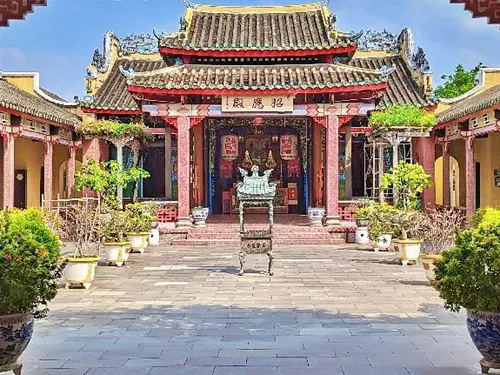
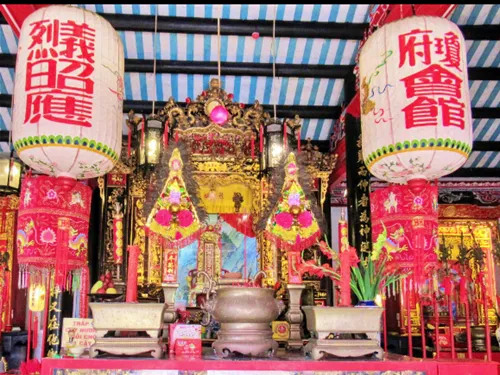
#362 – Trieu Chau Assembly Hall
(map, reviews)
This is Premium Content! To access it, please download our
Backpack and Snorkel Purple Travel GuideThe Trieu Chau Assembly Hall (or Hội Quán Triều Châu) was built in 1845 by the Chaozhou (Teochew) Chinese community, and it stands out for its unique focus on General Phục Ba (Ma Yuan), the god who controls the wind and calms the waves, reflecting the community's dependence on safe sea voyages. Its most remarkable feature is the stunning, intricate wooden carvings and sculptures that adorn its beams, columns, and altars, which showcase mythological creatures and folk stories in incredible detail, distinguishing it as a masterpiece of traditional Chaozhou craftsmanship. To fully appreciate its cultural significance and discover a local tradition for yourself, seek out the altar and witness the ongoing practice where local merchants and business owners still come to pray for good fortune and borrow symbolic money from the god to ensure a prosperous year. Find out more in our detailed Trieu Chau Assembly Hall guide.
#45/17 - Demonstration of sweet black sesame soup
(map, reviews)
This is Premium Content! To access it, please download our
Backpack and Snorkel Purple Travel GuideLocated at 45/17 Trần Hưng Đạo Street inside the quaint Ba Lê Well alleyway, Chè Xí Mà Phu offers more than just a tasty treat — it offers a living cultural experience showcasing how black sesame sweet soup (Chè mè đen) has been crafted in Hội An for centuries. The venue honors Mr. Ngô Thieu, the legendary ‘master of black sesame soup’, whose family has served locals and travelers for over 70 years.
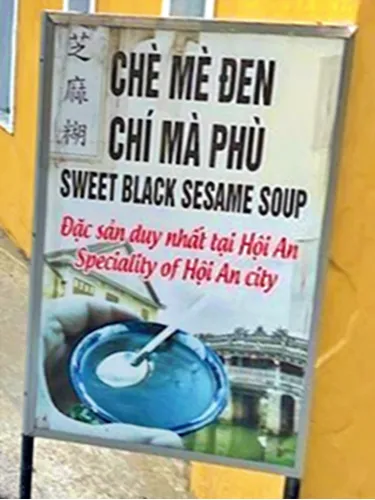
Artisanal Technique & Local Ingredients
Heirloom Recipe: Mr. Ngô Thieu learned the recipe from a Chinese master during his service with a portside family in the 1930s, and perfected it.
Local produce, authentic flavor: The recipe incorporates black sesame, kudzu/arrowroot powder, sweet potato, pennywort, apricot/malabar spinach leaves, cane sugar and, most importantly, Ba Lê Well water, known for imparting a unique, mellow sweetness.
Textural delight: The soup achieves a smooth, slightly thick consistency, distinctively nutty and comforting, and is best enjoyed slowly to appreciate its herbal undertones.
Hands-On Viewing: You can watch authentic stone-grinding of black sesame, wood-fire cooking, and the step-by-step preparation—complete with traditional stone grinders, charcoal stoves, mortar, bamboo trays, and ceramic bowls
Visitor Information
Location: 45/17 Trần Hưng Đạo St (Ba Lê Well Alley)
Opening Hours: approx. 8am – 8pm, daily
Entrance Fee: Included in the Hoi An Ancient Town ticket, but you need to buy the inexpensive black sesame soup to consume it
#66 – Hoi An traditional Art Performance House
(map, reviewse)
This is Premium Content! To access it, please download our
Backpack and Snorkel Purple Travel GuideBe advised that the shows are popular for very good reason, and arrive at least 30 min before show time at 10:15am, 3:15pm, 4:15pm.
If you cannot make it, but plan to go to My Son tomorrow, then you will have a chance to see a similar but shorter show at the My Son historic site that covers some of what you see during this show.
Give your feet a rest and treat your senses to an authentic cultural moment at the Hoi An Traditional Art Performance House. Right in the heart of the Ancient Town, this is where the vibrant, centuries-old traditions of Central Vietnam truly come to life. In a beautifully preserved setting, you can witness short, enthralling performances of folk singing, traditional dance, and unique theatrical acts like the renowned Bài Chòi (a local, musical bingo game). This stop provides a perfect, colorful insight into the living arts that have defined Hoi An's intangible heritage for generations, adding a dynamic, human element to your architectural tour. Click here for performance schedules, and essential visitor information for the Traditional Art Performance House


#6 – Japanese Culture Space (Japanese Culture Gallery)
(map, reviews)
This is Premium Content! To access it, please download our
Backpack and Snorkel Purple Travel GuideThe Japanese Culture Space (also known as the Japanese Culture Gallery) is the first and only museum in Hoi An dedicated entirely to the Japanese merchant community that thrived here over 400 years ago, helping to confirm the area as part of the historical nihonmachi (Japanese quarter). Housed within a beautifully preserved traditional Old Town house, the gallery showcases unique artifacts and documents, including a replica of an Omikoshi (a Japanese portable shrine), and historical evidence of the Red Seal Ships (Shuinsen) trade that linked Hoi An directly to Japan. For a hands-on experience and a deeper sense of the cultural connection, you can try out the traditional Japanese Tea Ceremony (sado/chado) space, learn the art of Origami paper folding, or even rent traditional Japanese costumes to take photos in the historic courtyard setting. Please see our detailed Japanese Culture Space guide for more information.
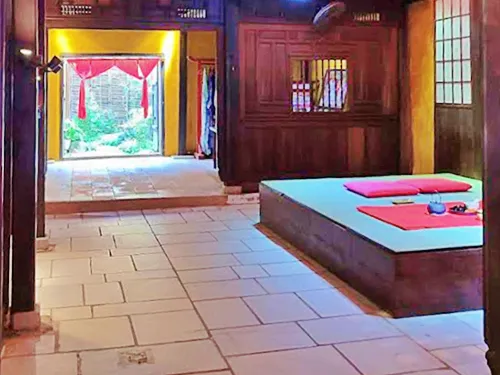
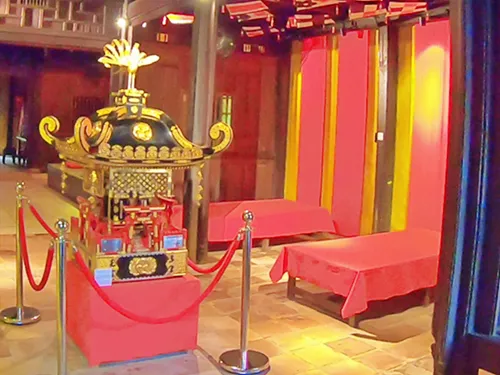
Where do you want to go now?
Author: Rudy at Backpack and Snorkel
Bio: Owner of Backpack and Snorkel Travel Guides. We create in-depth guides to help you plan unforgettable vacations around the world.
Other popular Purple Travel Guides you may be interested in:
Like this Backpack and Snorkel Purple Travel Guide? Pin these for later:


